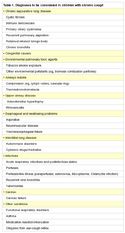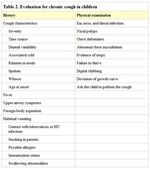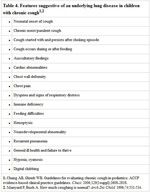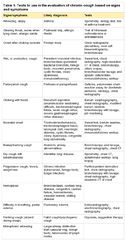- Clinical Technology
- Adult Immunization
- Hepatology
- Pediatric Immunization
- Screening
- Psychiatry
- Allergy
- Women's Health
- Cardiology
- Pediatrics
- Dermatology
- Endocrinology
- Pain Management
- Gastroenterology
- Infectious Disease
- Obesity Medicine
- Rheumatology
- Nephrology
- Neurology
- Pulmonology
Chronic Cough in Children: An Overview
The prevalence of chronic cough is reported to be 5% to 7% in preschoolers and 12% to 15% in older children. Diagnosis and management can present challenges.
According to guidelines from the Thoracic Society of Australia and New Zealand and the American College of Chest Physicians, cough is considered chronic in children if it lasts longer than 4 weeks1,2; in guidelines from the British Thoracic Society, cough is considered chronic if it lasts 8 weeks.3 In adults, cough that lasts longer than 8 weeks is considered chronic. The pediatric guidelines are based on the natural history of acute upper respiratory tract infections. Usually, 50% of children with cough related to acute viral illness recover by 10 days, 75% recover by 16 days, and 90% recover by 25 days.4
Chronic cough in children presents some unique challenges. Many adult diagnoses, such as chronic obstructive pulmonary disease and chronic bronchitis, are not recognized entities in the pediatric literature; therefore, the underlying diagnosis may be difficult to determine. Because of the distressing nature of the symptom, it may cause anxiety among family members.
Understandably, long-standing cough is stressful for the family and patient.5 Families may seek multiple medical consultations in quest of symptom resolution. In a study of 190 children, in a 12-month period, more than 80% had more than 5 doctor visits and more than 50% had more than 10 doctor visits for chronic cough.5 Clinical studies found 2 major fears expressed by mothers were that their child was going to die as a result of choking on phlegm or vomit or of an asthma attack or cot death and that their child would have long-term chest damage as a result of ongoing cough. Mothers reported disturbed sleep because of their fears.6PATHOPHYSIOLOGY
Cough is a protective reflex and a component of normal respiratory physiology. It enhances clearance of debris from the airway. The cough receptors are located from the larynx to the segmental bronchi. The afferent input is through the vagus nerve, and control occurs in the brainstem with cortical modulation. The efferent activity influences respiratory muscles. Cough reflex sensitivity (CRS) is affected by disease states and medications. Heightened CRS occurs with viral respiratory tract infections, asthma, gastroesophageal reflux disease (GERD), and angiotensin-converting enzyme inhibitor therapy. Children with neuromuscular weakness, chest wall deformities, tracheobronchomalacia, tracheostomies, and laryngeal dysfunction may not have an effective cough reflex. These children are at risk for aspiration, atelectasis, recurrent pneumonia, and chronic lung disease.
EPIDEMIOLOGY
The prevalence of chronic cough is reported to be 5% to 7% in preschoolers and 12% to 15% in older children.7 Cough can be classified as normal, or expected; chronic specific; or chronic nonspecific.
Normal, or expected, cough. This refers to cough in the absence of any disease states and likely represents the normal protective reflex phenomenon. In a study of healthy children with a mean age of 10 years, there was a mean frequency of 11.3 (range, 1 to 34) cough episodes per 24 hours.8 This was unaffected by passive smoking or the presence of furry pets in the home. However, nocturnal and prolonged coughing was unusual in these children.8 In older children, psychological stressors may cause cough.9,10Chronic specific cough. This type of cough is associated with other signs and symptoms suggestive of an underlying problem.
Chronic nonspecific cough. This type is characterized by dry cough in the absence of any identifiable respiratory disease. There are greater diagnostic and management challenges with this type of cough.
Table 1

Diagnoses to be considered in children with chronic cough
ETIOLOGY
The etiology of chronic cough depends on the age at onset. In a study of 108 pediatric patients with chronic cough (median age, 2.6 years), a final primary diagnosis was reached in 90%.11 The most common primary diagnosis was persistent bacterial bronchitis (39.8%). Natural resolution occurred in 22% of the patients. Asthma, GERD, and upper airway cough syndrome (UACS), common causes of chronic cough in adults, were found in only 9% of the patients. A secondary diagnosis of tracheomalacia, GERD, or obstructive sleep apnea was found 33%, 15%, and 2% of the patients, respectively.
In another study, the causes of cough in older children (mean age, 9.2 years) were found to be similar to those in adults (ie, UACS in 23%, GERD in 28%, asthma in 13%, and other diagnoses in 20%).12
Cough has been associated with environmental factors, such as outdoor and indoor air pollution. Particulate matter, irritant gases, tobacco smoke exposure, and dampness in the home have been implicated.13 The differential diagnosis of chronic cough in children is presented in Table 1.
Table 2

Elements of comprehensive evaluation for chronic cough in children
CLINICAL EVALUATION
A careful history and physical examination are essential for patients presenting with chronic cough. Table 2 highlights the important information to obtain in the history and physical examination.
Past medical history. The past medical history is important. Prematurity and surfactant-deficient lung disease may lead to chronic lung disease in older children. Infantile eczema predisposes to other atopic disorders, such as allergic rhinitis and asthma. Recurrent right middle lobe infiltrates and atelectasis are common diagnoses in children with asthma and increased mucus production. These conditions occur because of normally poor collateral ventilation of alveoli in the right middle lobe. A nonresolving pneumonia in one lobe may be caused by a congenital lung abnormality or focal airway obstruction. Severe infections caused by Bordetella pertussis or adenovirus have been associated with the subsequent development of bronchiectasis, bronchiolitis obliterans, and chronic lung disease.
Family history. A family history of asthma significantly raises the risk of an atopic disorder in the child. Contact history of tuberculosis should be carefully sought: ask about symptoms of cough, weight loss, and night sweats among close contacts.
Social/environmental history. As noted, cough has been associated with environmental factors, so ask about exposures to potential irritants.13 Chemical irritants, such as those from marijuana and cocaine, may lead to chronic cough. Fumes from biomass combustion of wood, crop residue, and dung (common in developing countries) may contribute to chronic cough. Inner-city children may be exposed to cockroach allergens. Exposure to pet dander may induce cough from bronchoconstriction, and exposure to bird and bat droppings may cause histoplasmosis with associated cough.
Table 3

Characteristics of cough and possible underlying conditionsTable 4

Features suggestive of an underlying lung disease in children with chronic cough
1,2
The quality of cough may indicate a specific diagnosis. Table 3 presents the characteristics of classic types of cough and the probable underlying disease. Important clinical features that point to a serious underlying disease process are listed in Table 4.
DIAGNOSTIC TESTS
Chronic cough can be associated with significant consequences; hence, each patient should be carefully evaluated. The extent of diagnostic testing should be based on the clinical setting. Adverse effects associated with tests should be carefully considered in children (eg, sedation and radiation). Table 5 provides a guide for tests in children with chronic cough based on signs and symptoms.
Chronic productive cough is always pathologic. Consider referral to a pediatric pulmonologist before embarking on potentially harmful tests.
There are only case series and cohort studies available to examine the value of available investigations for evaluation of chronic cough in children. Some of the tests that may be considered in children with chronic cough are discussed here.
Table 5

Tests to use in the evaluation of chronic cough based on signs and symptoms
Chest films. Radiographs are indicated for all children with chronic cough.14 When findings on a chest radiograph are abnormal, the odds ratio of a specific cause is 3.16 (95% confidence interval, 1.32 - 7.62).11 Bilateral diffuse peribronchial cuffing may indicate asthma, cystic fibrosis, persistent bacterial bronchitis, chronic aspiration, or primary ciliary dyskinesia. Asymmetry in aeration or vascular markings suggests the possibility of a foreign body, bronchial obstruction, vascular compression, or bronchial stenosis. Right middle lobe infiltrates are commonly seen with obstructive airway disease. Mediastinal widening may suggest hilar adenopathy and may be seen in diseases such as tuberculosis, histoplasmosis, lymphoma, and sarcoidosis.
Spirometry. This test is useful for detecting reversible airway hyperresponsiveness in children older than 6 years.15 Children as young as 3 years may also be able to participate in spirometry. It is an important tool for differentiating restrictive from obstructive diseases. Abnormalities of the inspiratory loop indicate extrathoracic obstruction.
CT scans. Chest and sinus CT scans have a role in the diagnosis of a purulent cough. They are the gold standard for examining the small airway and are more sensitive than spirometry.14 The lifetime cancer mortality risk from exposure to radiation from CT is 10 times greater for a child than for a middle-aged adult. For a single CT examination of 200 mA in a 2.5-year-old child, there is a 1 in 1000 to 2500 chance of cancer mortality.16 The use of CT for assessing small-airway and focal abnormalities has to be rationalized. It is important to consult with a pulmonologist before performing chest CT in a child to determine the goals and utility of a test that is potentially harmful.
Flexible bronchoscopy. Flexible bronchoscopy is indicated when a foreign body or an airway abnormality is suspected, when localized changes are noted on a radiologic study, for evaluation of aspiration, or when there is a need for bronchoalveolar lavage (BAL) or bronchial brushings.
Bronchoalveolar lavage. The specimen obtained with BAL is useful for microbiologic diagnostic purposes. However, the airway cellular and inflammatory profile can be used only as supportive data because adequate evidence is not available for this use of BAL in children. Cultures of BAL fluid for bacteria, viruses, and fungi are valuable for determining antimicrobial therapy.
Esophageal pH monitoring. GERD is not considered an important cause of isolated cough in a developmentally normal child; therefore, the value pH monitoring is questionable. When features suggestive of GERD are present, however, it may be useful.
Paranasal sinus imaging. When clinical features of sinusitis are present, sinus radiographs may be obtained. However, the sensitivity and specificity of these radiographs are undetermined.
Other tests. Studies have described increased airway sensitivity in different disease processes. However, the tests for airway sensitivity are not available in the clinical setting; they are available only for research purposes. The use of exhaled nitric oxide for determining the cause of chronic cough has not been studied.
ASSESSING THE EVIDENCE FOR UNDERLYING DISEASEIs it persistent bacterial bronchitis? Bacterial bronchitis is defined by a wet cough, cultures of BAL fluid positive for bacteria, and resolution with antibiotic therapy. An intense neutrophilic airway inflammatory response is seen on bronchoscopic examination. The most common causative organisms are Streptococcus pneumoniae,Haemophilus influenzae, and Moraxella catarrhalis. Patients in whom BAL fluid cultures have not been obtained may be given a 2-week trial of antibiotics.
Is it asthma? Isolated chronic cough without audible wheeze does not represent asthma. Children with persistent cough have less morbidity and less atopy than children with wheeze. In one study, a significant number of children with persistent cough had been given a diagnosis of asthma and were treated with asthma medications, including inhaled corticosteroids.17 However, only a minority of children with chronic unexplained cough have asthma-type airway inflammation. It is speculated that the increased percentage of neutrophils in BAL fluid from children with cough could relate to underlying persistent airways infection.18
Airway eosinophilia is associated with wheeze but is uncommon in children with persistent cough and frequent chest colds.19 Wheeze is a good discriminator for the presence of eosinophilic bronchitis, and persistent cough and recurrent chest colds without wheeze should not be considered a variant of asthma.19Is it pertussis? Pertussis may be overlooked as cause of chronic cough in adolescents. Data to determine the usefulness of symptoms classically associated with pertussis are limited. The presence of posttussive emesis or inspiratory whoop may increase the likelihood of pertussis. Absence of posttussive emesis and paroxysmal cough reduces the likelihood of pertussis.20 Clinicians must use their overall clinical impression when making decisions about empiric therapy for suspected pertussis.
Is it sinusitis? Sinusitis is commonly diagnosed in children, but it rarely can be proved and it is not associated with cough once doctor-diagnosed atopy is controlled for.21 Findings on a sinus radiograph may be abnormal in 18% to 82% of children.22 A systematic review of acute sinusitis in children concluded that “diagnostic modalities show poor concordance, and treatment options are based on inadequate data.”23TREATMENT
In children with chronic cough, treatment should be based on the underlying cause. For chronic nonspecific cough, empiric therapy may be used.
OTC cough medications. The American Academy of Pediatrics (AAP) has advised against use of dextromethorphan and codeine for treating cough. These medications have led to significant morbidity and some mortality related to intentional and accidental ingestion.24 Antihistamines also do not have a proven clinical benefit in treatment of chronic nonspecific cough.25Honey and lozenges. For cough associated with upper respiratory tract infection, the use of honey (children 1 year and older) and lozenges (children older than 6 years) is more beneficial than OTC cough preparations. However, adequate data on the use of honey and lozenges in children with chronic nonspecific cough are not available and no definite recommendation can be made.
Asthma therapy. If asthma is the diagnosis, it is important to follow the National Asthma Education Prevention Program guidelines. There are no data to support the empiric use of bronchodilators for chronic nonspecific cough.26 An empiric trial of bronchodilators and inhaled corticosteroids may be used for isolated dry cough, with evaluation at 2 to 4 weeks to determine response and need for continued use.2Therapy for upper airway cough syndrome. Empiric therapy with nasal corticosteroid sprays may be considered in older children with symptoms of allergic rhinitis and tonsillar hypertrophy.
GERD therapy. Case series have demonstrated some benefit of reflux therapy on cough. The North American Society for Pediatric Gastroenterology and Nutrition guideline included a discussion on cough and pediatric gastroesophageal reflux in the section on upper airway symptoms. It concluded that “. . . there is insufficient evidence and experience in children for a uniform approach to diagnosis and treatment.”27 A Cochrane review on GERD therapies like cisapride for cough has failed to find a beneficial effect.28 A Cochrane Database Review from 2011 concluded that proton pump inhibitors are not efficacious for treatment of cough associated with GERD.29
Antibiotics. This therapy should be considered if persistent bacterial bronchitis or persistent purulent rhinosinusitis (lasting more than 10 days) is a possible underlying cause for chronic cough. In a Cochrane review, patients with acute cough associated with common colds did not benefit from antimicrobial therapy.
Cessation of exposure to environmental toxins. Although there are inadequate data on beneficial effects of cessation of smoke exposure on chronic cough, the AAP has recommended avoidance of exposure to cigarette smoke in children. It is also important to eliminate environmental toxin exposure in management of cough.
Counseling. As part of a treatment regimen, counsel the family on the causes of cough specific to their child to help alleviate anxiety. Also, discuss the implications of chronic cough for the child’s health.
References:
References
1. Chang AB, Landau LI, van Asperen PP, et al; Thoracic Society of Australia and New Zealand. Cough in children: definitions and clinical evaluation. Med J Aust. 2006;184:398-403.
2. Chang AB, Glomb WB. Guidelines for evaluating chronic cough in pediatrics: ACCP evidence-based clinical practice guidelines. Chest. 2006;129(1suppl):260S-283S.
3. Shields MD, Bush A, Everard ML, et al; British Thoracic Society Cough Guideline Group. BTS guidelines: recommendations for the assessment and management of cough in children. Thorax. 2008;63(suppl 3):iii1–iii15.
4. Hay AD, Wilson A, Fahey T, Peters TJ. The duration of acute cough in pre-school children presenting to primary care: a prospective cohort study. Fam Pract. 2003;20:696-705.
5. Marchant JM, Newcombe PA, Juniper EF, et al. What is the burden of chronic cough for families? Chest. 2008;134:303-309.
6. Cornford CS, Morgan M, Ridsdale L. Why do mothers consult when their children cough? Fam Pract. 1993;10:193-196.
7. Stein RT, Holberg CJ, Sherrill D, et al. Influence of parental smoking on respiratory symptoms during the first decade of life: the Tucson Children’s Respiratory Study. Am J Epidemiol. 1999;149:1030-1037.
8. Munyard P, Bush A. How much coughing is normal? Arch Dis Child. 1996;74:531-534.
9. Butani L, O’Connell EJ. Functional respiratory disorders. Ann Allergy Asthma Immunol. 1997;79:91-99.
10. Rietveld S, Rijssenbeek-Nouwens LH, Prins PJ. Cough as the ambiguous indicator of airway obstruction in asthma. J Asthma. 1999;36:177-186.
11. Marchant JM, Masters IB, Taylor SM, et al. Evaluation and outcome of young children with chronic cough. Chest. 2006;129:1132-1141.
12. Donnelly D. Critchlow A, Everard ML. Outcomes in children treated for persistent bacterial bronchitis. Thorax. 2007;62:80-84.
13. Fuentes-Leonarte V, TenÃas JM, Ballester F. Levels of pollutants in indoor air and respiratory health in preschool children: a systematic review. Pediatr Pulmonol. 2009;44:231-243.
14. Chang AB, Masel JP, Boyce NC, et al. Non-CF bronchiectasis: clinical and HRCT evaluation. Pediatr Pulmonol. 2003;35:477-483.
15. König P. Hidden asthma in children. Am J Dis Child. 1981;135:1053-1055.
16. Brenner DJ. Estimating cancer risks from pediatric CT: going from the qualitative to the quantitative. Pediatr Radiol. 2002;32:228-233.
17. Faniran AO, Peat JK, Woolcock AJ. Measuring persistent cough in children in epidemiological studies: development of a questionnaire and assessment of prevalence in two countries. Chest. 1999;115:434-439.
18. Fitch PS, Brown V, Schock BC, et al. Chronic cough in children: bronchoalveolar lavage findings. Eur Respir J. 2000;16:1109-1114.
19. Gibson PG, Simpson JL, Chalmers AC, et al. Airway eosinophilia is associated with wheeze but is uncommon in children with persistent cough and frequent chest colds. Am J Respir Crit Care Med. 2001;164:977-981.
20. Cornia PB, Hersh AL, Lipsky BA, et al. Does this coughing adolescent or adult have pertussis. JAMA. 2010;304:890-896.
21. Lombardi E, Stein RT, Wright AL, et al. The relation between physician-diagnosed sinusitis, asthma, and skin test reactivity to allergens in 8-year-old children. Pediatr Pulmonol. 1996;22:141-146.
22. Shopfner CE, Rossi JO. Roentgen evaluation of the paranasal sinuses in children. Am J Roentgenol Radium Ther Nucl Med. 1973;118:176-186.
23. Ioannidis JP, Lau J. Technical report: evidence for the diagnosis and treatment of acute uncomplicated sinusitis in children: a systematic overview. Pediatrics. 2001;108:E57.
24. Lokker N, Sanders L, Perrin EM, et al. Parental misinterpretations of over-the-counter pediatric cough and cold medication labels. Pediatrics. 2009;123:1464-1471.
25. Schaefer MK, Shehab N, Cohen AL, Budnitz DS. Adverse events from cough and cold medications in children. Pediatrics. 2008;121:783-787.
26. Irwin RS, Baumann MH, Bolser DC, et al; American College of Chest Physicians (ACCP). Diagnosis and management of cough executive summary: ACCP evidence-based clinical practice guidelines. Chest. 2006;129(1 suppl):1S-23S.
27. Rudolph CD, Mazur LJ, Liptak GS et al; North American Society for Pediatric Gastroenterology and Nutrition. Guidelines for evaluation and treatment of gastroesophageal reflux in infants and children: recommendations of the North American Society for Pediatric Gastroenterology and Nutrition. J Pediatr Gastroenterol Nutr. 2001;32(suppl 2):S1-S31.
28. Maclennan S, Augood C, Cash-Gibson L, Logan S, Gilbert RE. Cisapride treatment for gastro-oesophageal reflux in children. Cochrane Database Syst Rev. 2010;14:CD002300. Review.
29. Chang AB, Lasserson TJ, Gaffney J, Connor FL, Garske LA. Gastro-oesophageal reflux treatment for prolonged non-specific cough in children and adults. Cochrane Database Syst Rev. 2011;1:CD004823.
30. Arroll B, Kenealy T. Antibiotics for the common cold and acute purulent rhinitis. Cochrane Database Syst Rev. 2005;3:CD000247.
